Gentle movement offers powerful benefits for seniors with mobility challenges. You’ll find chair-based exercises like seated marching and arm raises improve strength without standing. Virtual reality programs provide engaging, therapist-designed workouts with 91% of seniors finding them easy to use. Safe home spaces with sturdy chairs and non-slip mats enhance your exercise experience. Group activities reduce isolation while seasonal movements keep routines fresh. Discover how these accessible adventures can transform your daily independence and wellbeing.
The Surprising Benefits of Gentle Movement for Seniors
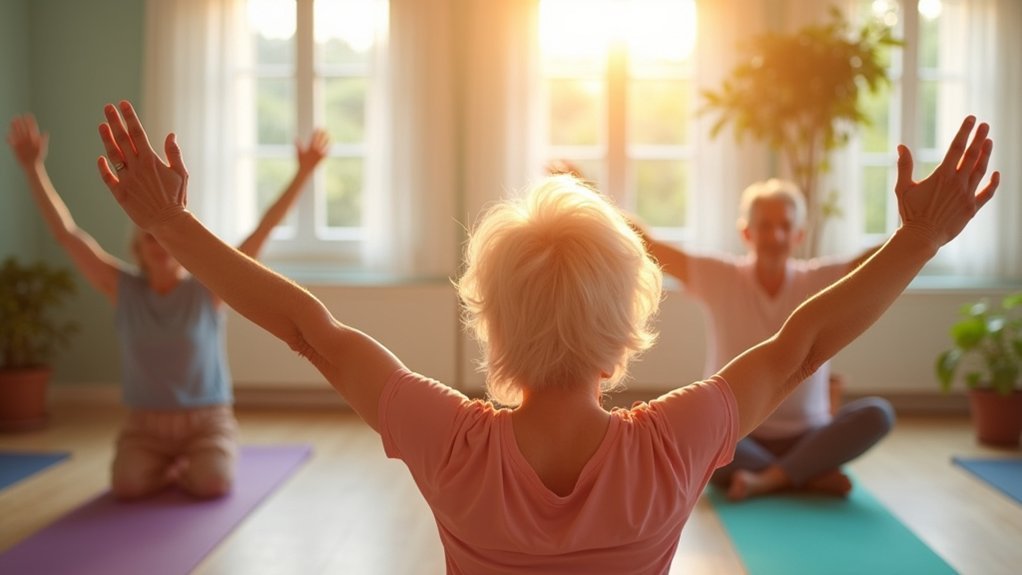
Although many seniors assume high-intensity exercise is necessary for good health, gentle movement offers remarkable benefits that can transform your golden years.
High-intensity workouts aren’t required—gentle movement can profoundly enhance your senior years with surprising health benefits.
You’ll maintain muscle strength for daily tasks while improving balance and coordination—reducing your risk of falls. Your immune system gets a boost, and you’ll protect against osteoporosis and muscle loss. Regular stretching helps restore spinal mobility and promotes overall joint health.
Don’t underestimate the mental health advantages: gentle, repetitive movements have a meditative effect, releasing mood-enhancing endorphins while reducing depression and anxiety.
When you join group classes, you’ll gain social connections that combat isolation and loneliness.
The best part? These exercises can be adapted to your mobility level and performed at home or community centers. You don’t need vigorous workouts to reap significant health rewards.
Chair-Based Exercises That Transform Mobility
Chair exercises offer you a powerful way to build strength without needing to stand, giving your muscles essential resistance work even with limited mobility.
You’ll boost circulation throughout your body with seated movements that pump blood to extremities, reducing stiffness and promoting healing in joints and tissues.
These accessible routines build your confidence as you master increasingly challenging movements, creating a positive cycle where physical capability enhances your self-assurance in daily activities. You can incorporate exercises like the seated march to improve your heart health while remaining comfortably seated.
Strengthening Without Standing Up
When mobility becomes a challenge, strengthening exercises don’t need to be abandoned—they simply need adaptation. Chair-based exercises offer impressive benefits for seniors, improving both upper and lower body strength while reducing fall risks. Recent studies show that a 14-week chair exercise program can significantly increase salivary testosterone levels in older adults.
You’ll find these seated workouts particularly accessible, with higher compliance rates than standing routines. They’re adaptable to your home environment and can be performed in short, manageable sessions.
| Exercise Type | Benefits | Difficulty |
|---|---|---|
| Seated Marching | Improves leg strength | Beginner |
| Arm Curls | Enhances grip strength | Beginner |
| Chair Squats | Builds functional strength | Intermediate |
These exercises don’t just strengthen your body—they boost mental well-being too. Regular participation reduces depression symptoms while promoting independence. With professional guidance, you’ll maintain proper form and maximize safety throughout your strengthening journey.
Seated Circulation Boosters
Poor circulation can considerably impact your quality of life, but gentle movement while seated offers powerful solutions. Simple exercises like seated marches and toe raises enhance blood flow, preventing swelling in your legs and feet.
Try incorporating leg swings and seated lifts into your daily routine to improve hip flexibility while boosting circulation. For upper body benefits, add arm raises that strengthen shoulders while increasing blood flow. Remember to shake out arms and legs after completing each exercise to effectively relieve muscle tension. These movements require no special equipment—just a sturdy chair.
Chair-based exercises aren’t just about circulation; they’re gentle on your joints while maintaining essential muscle mass.
You’ll notice improved balance, flexibility, and cardiovascular health with consistent practice. Best of all, these exercises adapt to your personal mobility level, helping you maintain independence and perform daily activities with greater ease.
Confidence Through Chair Fitness
Transformation begins in the simplest of settings—a sturdy chair can become your gateway to renewed mobility and confidence. When you engage in chair-based exercises, you’re building strength and endurance essential for everyday activities while improving your posture and reducing fatigue.
These accessible workouts strengthen your core muscles, enhancing balance and coordination to prevent falls and support independence. You’ll notice increased flexibility and range of motion, making daily tasks easier and reducing joint discomfort. Proper exercise techniques help maintain your spine’s natural S shape rather than allowing it to collapse into an unhealthy C-curve.
Beyond physical benefits, chair exercises boost your mental wellbeing by reducing stress and anxiety. The sense of accomplishment you’ll feel improves cognitive function and fosters self-worth.
Since these routines adapt to various mobility levels and fit easily into daily life, you’re more likely to maintain consistency—building confidence with every session.
Virtual Reality: A New Frontier in Senior Fitness
Virtual reality fitness programs now come with simplified interfaces and adaptive equipment that you’ll find surprisingly easy to use regardless of your technical experience.
You can experience the unique benefits of VR’s mind-body connection through guided meditation landscapes or gentle tai chi sessions that respond to your movements in real-time.
Recent studies have demonstrated that biweekly VR exercise sessions can lead to significant improvement in functional fitness for older adults, including enhanced flexibility, strength, and balance.
These technological innovations specifically target fall prevention by offering balance training exercises in safe, virtual environments where you can practice challenging movements without fear of injury.
VR Accessibility Solutions
As the digital landscape evolves, remarkable VR accessibility solutions have emerged that make this cutting-edge technology surprisingly approachable for seniors of all abilities.
The evidence speaks volumes—over 91% of seniors rate VR systems as “easy” or “very easy” to use, even those with limited tech experience.
You’ll find VR systems designed specifically with your comfort and safety in mind, accommodating physical limitations while still delivering engaging experiences. Many platforms feature special options for virtual walking tours that can be enjoyed from a seated position.
Successful programs typically include:
- Structured sessions averaging twice weekly for maximum benefits
- Staff support and training to overcome initial hesitations
- Age-appropriate content selection from 65 to 100+ years
- Hardware modifications for physical comfort and accessibility
These adaptations guarantee you can enjoy VR’s cognitive and physical benefits regardless of your mobility level or tech familiarity.
Mind-Body Virtual Engagement
Three revolutionary dimensions of virtual reality have transformed how seniors experience exercise, blending physical movement with mental engagement.
VR-enhanced programs stimulate both cognitive function and physical fitness simultaneously, creating a more holistic approach to wellness.
You’ll find these immersive experiences particularly beneficial for mental health, as they reduce stress while providing therapeutic emotional benefits.
The engaging nature of VR makes exercises more enjoyable, increasing your motivation and adherence compared to traditional routines.
Whether at home or in care facilities, these platforms offer customized, therapist-designed workouts tailored to your specific needs. Studies involving both home-based and facility-based samples have shown participants find these programs enjoyable and motivating.
Though not a replacement for human connection, VR environments can enhance feelings of social participation while improving functional fitness.
The interactive feedback systems continuously adjust to your performance, making each session both safe and effective.
Fall Prevention Technology
With falls affecting one in four older adults annually, virtual reality technology has emerged as a powerful tool for prevention and intervention.
You’ll benefit from VR’s ability to improve your balance through sensory integration while strengthening your skeletal muscles and nervous system functions.
Studies show VR training improves gait and balance function considerably better than traditional methods, reducing falls by approximately 21%. The technology’s success depends largely on how useful and enjoyable you find it.
- Realistic scenarios mimic daily situations, enhancing fall risk assessment
- Personalized training adapts to your specific mobility challenges
- Immersive environments increase engagement during balance exercises
- Integration of visual, auditory, and somatosensory feedback improves self-awareness
VR’s customization and engagement factors make it particularly effective for seniors seeking to maintain independence.
Creating Safe Movement Spaces at Home
Creating a safe environment for movement at home is essential for seniors looking to maintain their fitness and independence. Start by ensuring your chairs are stable and positioned to allow easy access, giving you confidence during seated exercises.
Clear all pathways of potential trip hazards and consider adding non-slip mats in areas where you’ll be moving. These simple adjustments considerably reduce fall risks while providing secure footing.
Good lighting is vital for seeing exercises clearly, so brighten up your movement space with adequate lamps or natural light.
You’ll also want to minimize distractions by turning off TVs or loud appliances during your exercise time.
These thoughtful modifications transform ordinary spaces into safe havens for gentle movement, allowing you to focus entirely on your fitness journey.
Keep a bottle of water nearby to maintain proper hydration during your workout sessions, as staying hydrated is crucial for safety and effectiveness when exercising.
Adaptive Equipment That Makes Exercise Accessible
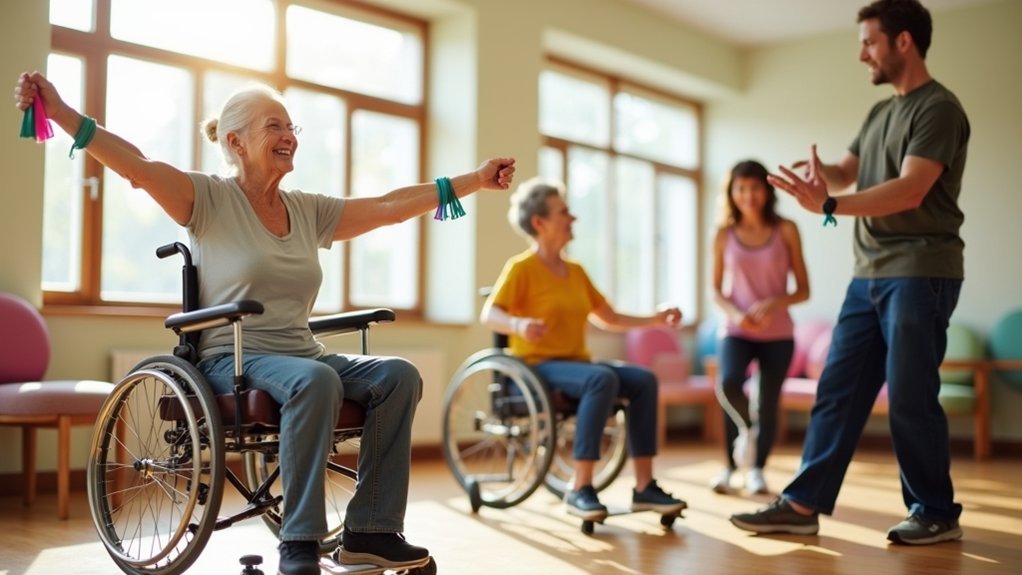
Adaptive equipment has revolutionized exercise possibilities for seniors facing mobility challenges, making fitness accessible regardless of physical limitations.
You’ll find numerous options designed specifically to support your fitness journey while accommodating reduced mobility. Equip Products offers adjustable resistance levels that allow for personalized workout intensity as strength and comfort levels change over time.
- Seated exercise tools like FlexCycle Under Desk Bikes and seated elliptical machines provide cardiovascular benefits without stressing your joints.
- Support devices such as standing frames and walking aids help improve balance and posture during exercise.
- Adaptive grip aids including Active Hands gripping tools offer independence for those with limited hand mobility.
- Therapeutic equipment like resistance bands and chair yoga props can be adjusted to various strength levels, making them perfect for progressive exercise programs.
The Social Side of Movement: Group Activities for Limited Mobility
You’ll find remarkable benefits when joining movement groups tailored for limited mobility, from improved physical function to reduced feelings of isolation.
Group activities create natural opportunities for connection as you share both challenges and victories with others who understand your experience. Research shows that participants consistently cite social interaction as a significant factor in their enjoyment and ongoing motivation to attend exercise sessions.
Whether it’s chair yoga, water aerobics, or gentle dance classes, these shared fitness experiences strengthen both your body and social connections.
Shared Fitness Fun
Laughter and camaraderie fill the room as seniors gather for their weekly exercise session.
You’ll find these group activities offer more than just physical benefits—they’re cost-effective opportunities for social connection while improving your mobility and independence.
Even with limited mobility, you can participate in structured one-hour sessions that adapt to your abilities.
- Programs typically include stretching, balance work, and low-impact strength training
- Social time after exercise enhances connections and improves overall wellbeing
- Regular participation reduces frailty levels and helps maintain independence
- Groups create accountability, resulting in higher attendance rates
Don’t let mobility limitations hold you back.
Community-based fitness programs create supportive environments where you’ll enjoy movement alongside others facing similar challenges—making exercise something to look forward to rather than dread.
Programs like Tai Chi Prime combine gentle movement with socialization to improve balance and reduce fall risk in just six weeks.
Connection Through Movement
The simple act of moving together creates powerful social bonds that can transform your exercise routine into a meaningful life experience. When you join group activities, you’re not just improving physical health—you’re building a support network that keeps you motivated and engaged.
Look for programs that offer variety and accommodate different mobility levels. Low-impact classes like tai chi or yoga, music-based activities, and even arts and crafts sessions can provide both social connection and gentle movement benefits. Chair yoga is especially beneficial as it offers gentle movements while ensuring safety and comfort for those with mobility limitations.
Even virtual programs can help if leaving home is challenging. These shared experiences reduce loneliness while improving your physical function.
You’ll learn new techniques from peers and instructors while developing relationships that provide emotional support. The camaraderie you’ll find in these groups often becomes the reason you’ll keep coming back.
Water-Based Exercises for Joint-Friendly Fitness
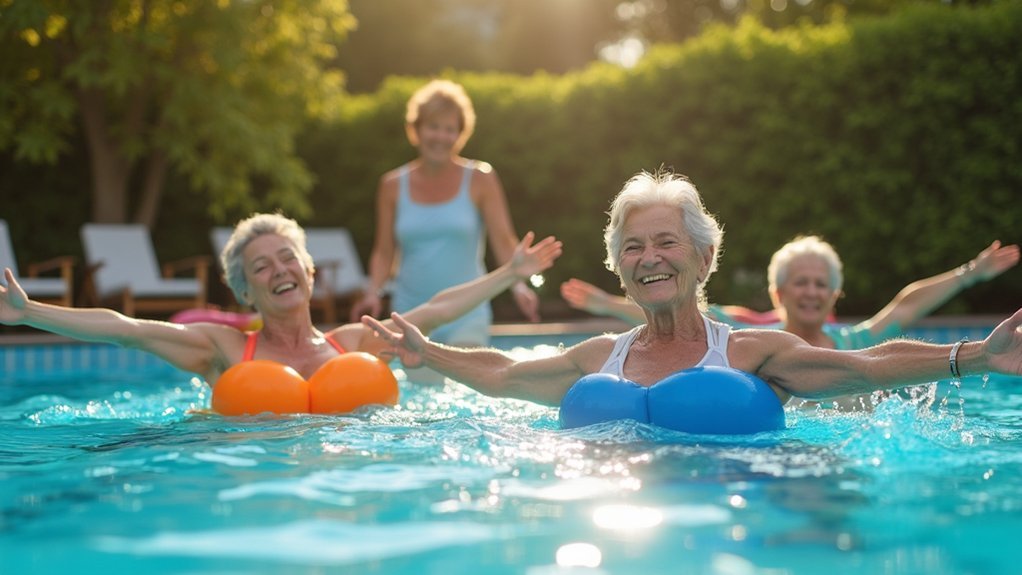
Water provides an ideal environment for seniors with limited mobility to exercise safely and effectively. The buoyancy supports your body weight, reducing stress on painful joints while the gentle resistance strengthens muscles.
You’ll find that water workouts can improve your cardiovascular health without the high impact of land exercises.
- Try arm curls with foam water weights to build upper body strength
- Practice aqua walking or marching with high knees to enhance balance and leg strength
- Use the pool wall for support while lifting your knees toward your chest for core stability
- Incorporate gentle floating stretches to increase your flexibility safely
For best results, aim for three to five sessions weekly in comfortably warm water with proper supervision.
Begin with walking in the shallow end from wall to wall, and gradually increase your pace as you build endurance.
Always consult your healthcare provider before starting.
Breathing Techniques to Enhance Movement Quality
Breathing properly transforms how you move, making every gentle exercise more effective and beneficial for your body. Studies show that techniques like coherent breathing and inspiratory muscle training (IMT) greatly improve balance, gait, and functional capacity in seniors. Research demonstrates that these breathing techniques significantly reduce fall risks among elderly populations, which is a major concern related to balance and gait impairments.
| Technique | Benefits | Best For |
|---|---|---|
| Coherent Breathing | Enhances balance, reduces fall risk | Daily practice |
| Inspiratory Muscle Training | Increases lung capacity, improves gait | Supervised sessions |
| Motor Development Patterns | Boosts functional fitness, flexibility | Combining with movement |
You’ll experience better cardiovascular health, increased muscle strength, and improved dynamic balance through regular practice. For best results, combine these breathing exercises with your physical activities and start with simple techniques that you can gradually build upon at home or during supervised sessions.
Mindful Movement: Combining Mental and Physical Wellness
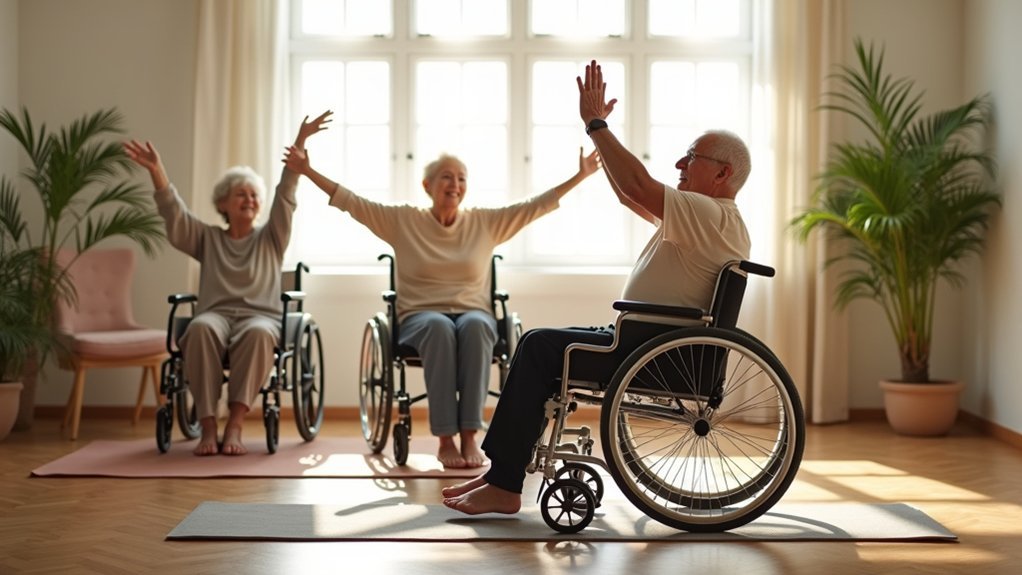
Mindful movement brings together the power of breath with purposeful attention, creating a holistic approach to wellness for seniors. By focusing on both mental awareness and physical activity, you’ll experience benefits beyond typical exercise routines.
Harness the breath-movement connection for whole-person wellness that transcends ordinary senior fitness programs.
You’ll notice improved cognitive function, enhanced balance, and reduced stress levels as you practice. Regular mindful movement sessions can significantly reduce depression and anxiety in older adults.
- Combine gentle movement with present-moment awareness to manage chronic pain more effectively
- Practice in group settings to foster social connections while improving your emotional well-being
- Start with guided sessions tailored to your mobility level for maximum benefit
- Integrate brief mindfulness techniques into daily activities like walking or stretching
This accessible practice doesn’t require special equipment and can be adapted to various abilities.
As you cultivate bodily awareness, you’ll develop greater independence and confidence in your movements.
Seasonal Movement Activities for Year-Round Engagement
Four distinct seasons offer unique opportunities for seniors to stay active throughout the year.
In spring, embrace seated stretches and low-impact cardio to improve flexibility as temperatures warm.
Summer brings perfect conditions for armchair travel adventures or outdoor concerts that combine social engagement with relaxation. Tending to a windowsill garden can be a fulfilling activity that enhances both physical and mental health for seniors with limited mobility.
As autumn arrives, explore accessible nature trails to enjoy colorful foliage while getting gentle exercise. These paths provide safe surfaces for balanced walking.
Winter months needn’t limit activity—focus on indoor pursuits like brain games and reading groups that maintain mental sharpness.
Don’t forget year-round options like chair yoga, water aerobics for joint-friendly movement, or seated dance classes that combine physical benefits with social interaction.
Even fishing offers a wonderful way to connect with nature while staying comfortably seated.
Measuring Progress: Small Victories in Mobility Improvement
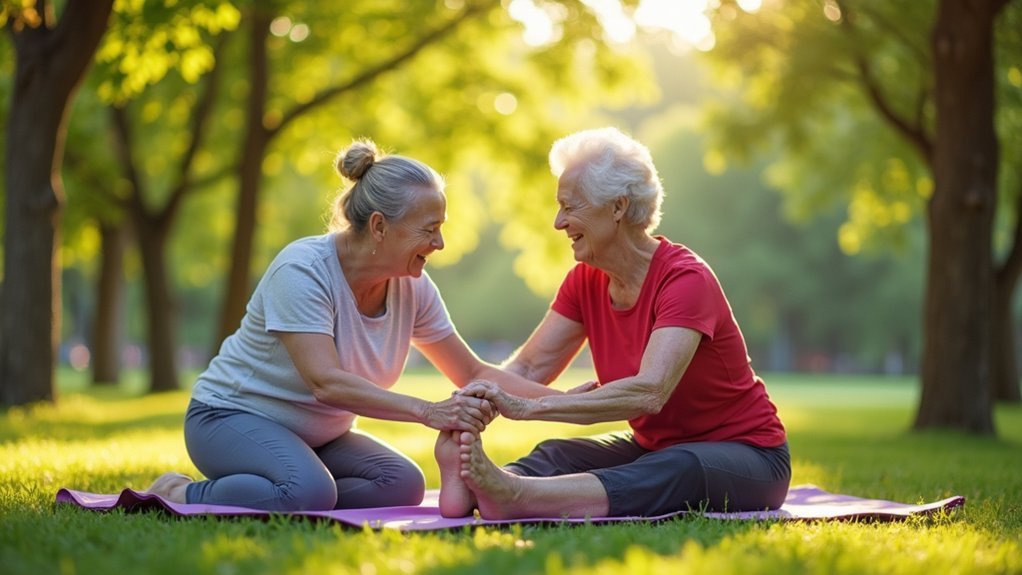
Tracking your mobility journey means celebrating every step forward, however small it might seem. Progress happens in both measurable ways, like improved walking speed, and in how you feel about your movement abilities.
The Elderly Mobility Scale (EMS) offers a structured way to monitor your advancement through everyday tasks like transfers and walking. This assessment tool provides scores ranging from 0 to 20, evaluating seven key mobility tasks across different difficulty levels.
- Notice when daily activities become easier—perhaps you’re rising from a chair with less assistance
- Track objective measurements such as increased walking distance or improved balance time
- Acknowledge your growing confidence and reduced fear of falling
- Celebrate incremental gains in strength, flexibility, or range of motion
Combining these objective and subjective indicators creates a complete picture of your mobility improvements, validating each small victory along the way.
Caregiver Participation: Supporting Your Loved One’s Movement Journey
As a caregiver, your partnership in a senior’s movement journey creates a foundation for success that extends far beyond physical assistance. Your empathy and understanding form the emotional bedrock that encourages consistent participation.
You’ll find that exercising together transforms routine into quality time while providing essential safety monitoring. When you demonstrate movements first, you’re not just showing technique—you’re building confidence.
Design personalized activities that respect limitations while celebrating small victories. Your encouragement of group exercise classes can significantly reduce feelings of isolation while adding social motivation to their fitness routine. Remember that technology can be your ally; consider using simple fitness trackers to monitor progress together.
The most effective support you can offer isn’t just physical spotting during tai chi or walking—it’s your presence that transforms exercise from a health chore into an enriching daily ritual you both enjoy.
Technology Tools That Make Movement More Engaging
Technology has revolutionized how seniors engage with movement exercises, making fitness more accessible, enjoyable, and effective than ever before.
From smart devices to virtual experiences, these innovations help you overcome physical limitations while adding fun to your daily routine.
- Exergaming combines exercise with gaming, transforming physical therapy into an engaging activity that you’ll look forward to completing.
- Virtual reality experiences offer immersive environments where you can explore new places while gently moving your body.
- Smart canes and mobility aids equipped with sensors provide greater independence and confidence during movement activities.
- Wearable devices track your progress, offering motivational feedback and helping you set achievable goals for your movement journey.
With the global aging population expanding rapidly, technology developers are increasingly focused on creating solutions specifically designed for seniors’ unique movement needs.
Frequently Asked Questions
How Long Should Each Exercise Session Last for Limited Mobility Seniors?
You should aim for 5-10 minute sessions initially. You’ll benefit from even 6 minutes daily. As you progress, you can gradually extend your workout time while monitoring your comfort and fatigue levels.
Can Medication Timing Affect Exercise Performance and Safety?
Yes, medication timing greatly affects your exercise safety. Take long-acting medications well before workouts to avoid drowsiness. Schedule diuretics earlier in the day and time pain relievers to peak during your movement sessions.
What Exercises Help Manage Specific Chronic Conditions Like Arthritis?
For arthritis management, you’ll benefit from water aerobics, gentle chair yoga, and range of motion exercises. Try swimming to reduce joint stress, seated marches for circulation, and shoulder rolls to improve flexibility and decrease pain.
How Do I Modify Exercises During Pain Flare-Ups?
During flare-ups, you’ll need to reduce intensity and duration of your exercises. Choose low-impact alternatives, use heat before activity, take frequent rest breaks, and stop if pain worsens considerably.
When Should I Consult a Physical Therapist Versus Exercising Independently?
Consult a physical therapist when you have severe mobility issues, chronic conditions, post-surgery recovery, or pain. Exercise independently for light activities and maintenance when you’re stable and know proper techniques.
In Summary
You’ve discovered that movement isn’t just possible—it’s transformative, regardless of your mobility limitations. Whether you’re trying chair yoga, exploring VR worlds, or simply stretching with adaptive equipment, you’re building strength and independence. Remember, progress happens in small moments, not grand gestures. With technology, caregiver support, and seasonal activities, you’ll continue finding joy in movement that honors your body’s unique capabilities.

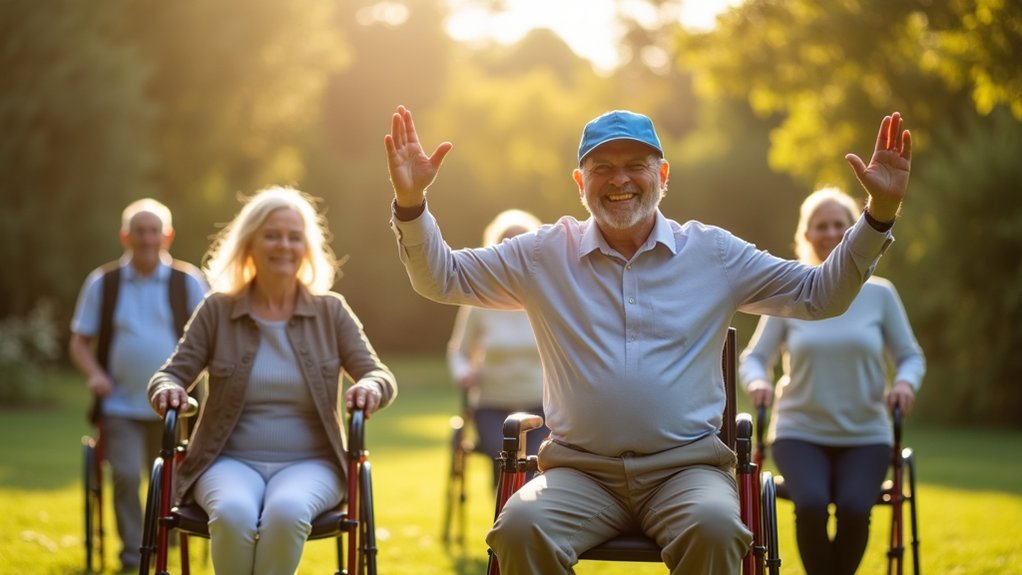



Leave a Reply